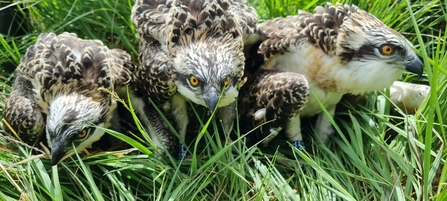
The 2023 Foulshaw osprey chicks wearing their newly fitted ID leg rings in June: Two females and one male, Foulshaw Moss Nature Reserve © Cumbria Wildlife Trust
Gifting membership? Order by Wednesday 17 December in time for Christmas.

The 2023 Foulshaw osprey chicks wearing their newly fitted ID leg rings in June: Two females and one male, Foulshaw Moss Nature Reserve © Cumbria Wildlife Trust
Three six-week-old osprey chicks were tagged with ID rings at Foulshaw Moss Nature Reserve recently, a major breeding sites for these spectacular birds of prey. The event was a key moment in osprey conservation as the parent ospreys, Blue 35 and White YW, have now successfully bred every year for a decade at this wetland nature reserve.
Paul Waterhouse, Reserves Officer for Cumbria Wildlife Trust said: “It’s great to have ringed another brood of osprey chicks, for the 10th year running! So far, we’ve tagged a total of 27 osprey chicks at Foulshaw Moss. They were weighed by a licenced and experienced bird ringer and each chick was given a coloured ID leg ring. This year we have one male and two females. All three chicks are doing very well. Soon they’ll start to fledge and I’d urge anyone who hasn’t visited us yet this summer to come to Foulshaw Moss to see them. You’ve got a couple of months before these incredible birds of prey leave us for their long migration, most likely to west Africa.”
Paul explains the importance of tagging and ringing the osprey chicks:
“The tags are invaluable as they enable us to identify the birds individually, to keep tracks of their movements and understand their life history. They have been fitted with metal rings, as part of the national bird ringing scheme and also a plastic coloured ring, which allows individual birds to be identified in the field using a telescope or telephoto camera. Thanks to these tags, we’ve had several sightings of Foulshaw Moss ospreys around the world, in particular in the Gambia.”
“Due to increasing cases of avian influenza across the country, we’ve been following guidance from the British Trust for Ornithology (BTO) while carrying out our ringing operation this season. Although ospreys are considered low risk for the disease, it’s always best to put procedures in place to reduce any risk.”
As the osprey is a Schedule 1 protected species, only those with a licence from the BTO are permitted to approach and handle the birds.
Foulshaw Moss Nature Reserve is home not only to migrating ospreys, but other birds of prey including peregrine and marsh harrier. In the summer months, it’s alive with dragonflies and butterflies, wetland-loving plants such as Sphagnum moss and bog rosemary, and adders and lizards can be seen basking in the sun.
Foulshaw Moss Nature Reserve is open daily, free of charge. It’s located off the A590 near Witherslack.
We're offering special half-day Wildlife Experiences at Foulshaw Moss Nature Reserve throughout summer, to showcase the wealth of wildlife found there. You’ll have exclusive access to parts of the nature reserve not normally open to the public. Click here for more details and to book.
We hope you enjoy watching this family of ospreys through the webcam for the whole season. It costs us around £12,000 to get and keep the osprey webcam running for the season. If you can, please donate to help with the costs to keep this broadcasting for you.
Use #FoulshawOspreys to join the osprey conversation on social.